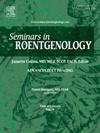纵隔和肺门淋巴结病的影像学评价:方法、分类和鉴别诊断
IF 1.3
4区 医学
Q4 RADIOLOGY, NUCLEAR MEDICINE & MEDICAL IMAGING
引用次数: 0
摘要
纵隔和肺门淋巴结病变是胸部影像学的常见发现,需要彻底的评估以区分短暂的、反应性的、恶性的和非恶性的原因。本文综述了胸淋巴结的解剖、功能和引流模式,包括国际肺癌研究协会(IASLC)的分类系统,该系统标准化了肺癌分期的淋巴结站和更广泛的诊断应用。成像方式,如胸部x线摄影(CXR)和计算机断层扫描(CT)在评估淋巴结病中起着至关重要的作用,CT是首选的工具,因为它能够表征大小、形状、边界、密度和增强模式。特定的影像学特征,包括淋巴结大小阈值、钙化模式、坏死和分布,有助于缩小鉴别诊断范围,区分恶性和良性疾病,如结核、结节病、淋巴瘤和转移性肿瘤。此外,纵隔外淋巴结的累及可以为全身性疾病提供诊断线索。系统的成像方法可以提高诊断的准确性,指导适当的临床管理和必要时的组织采样。本文章由计算机程序翻译,如有差异,请以英文原文为准。
Imaging Evaluation of Mediastinal and Hilar Lymphadenopathy: Approach, Classification, and Differential Diagnosis
Mediastinal and hilar lymphadenopathy is a frequent finding in thoracic imaging, necessitating thorough evaluation to distinguish between transient, reactive, malignant, and non-malignant causes. This review explores the anatomy, function, and drainage patterns of thoracic lymph nodes, including the International Association for the Study of Lung Cancer (IASLC) classification system, which standardizes lymph node stations for lung cancer staging and broader diagnostic applications. Imaging modalities such as chest radiography (CXR) and computed tomography (CT) play crucial roles in assessing lymphadenopathy, with CT being the preferred tool due to its ability to characterize size, shape, borders, density, and enhancement patterns. Specific imaging features, including nodal size thresholds, calcification patterns, necrosis, and distribution, help narrow differential diagnoses, distinguishing between malignant and benign conditions such as tuberculosis, sarcoidosis, lymphoma, and metastases. Additionally, the involvement of extra-mediastinal nodes can provide diagnostic clues to systemic diseases. A systematic imaging approach enhances diagnostic accuracy, guiding appropriate clinical management and tissue sampling when necessary.
求助全文
通过发布文献求助,成功后即可免费获取论文全文。
去求助
来源期刊

Seminars in Roentgenology
医学-核医学
CiteScore
0.90
自引率
0.00%
发文量
49
审稿时长
51 days
期刊介绍:
Seminars in Roentgenology is designed primarily for the practicing radiologist and for the resident. Each quarterly issue compiled by a leading guest editor covers a single topic of current importance. The clinical, pathological, and roentgenologic aspects are emphasized, while research and techniques are discussed insofar as they provide documentation and clarification of the subject under discussion. This Seminars series is of interest to radiologists, sonographers, and radiologic technicians.
 求助内容:
求助内容: 应助结果提醒方式:
应助结果提醒方式:


